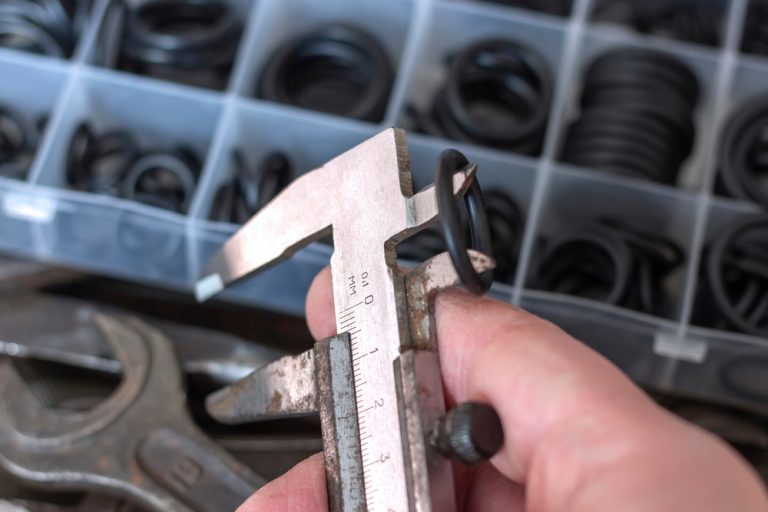O-rings are crucial components in various industries, serving as reliable seals in hydraulic and pneumatic systems. Ensuring their optimal performance is critical to preventing leaks and maintaining efficiency.
In this blog, the team at EZ Coating shares how to measure, stretch, and shrink o-rings.
How to Measure O-Rings
Accurate measurement is the first step in ensuring the proper functioning of O-rings. Incorrect measurements can lead to ill-fitting seals, resulting in leaks and potential system failures.
Here’s a step-by-step guide on how to measure O-rings effectively
- Determine the cross-section diameter (CS): Measure the width of the O-Ring from one inner edge to the other. This measurement is crucial for identifying the size of replacement O-rings.
- Inner diameter (ID) measurement: Measure the distance across the inner circle of the O-Ring. Ensure the caliper or measuring tool is perpendicular to the axis of the ring to get an accurate measurement.
- Outer diameter (OD) measurement: Measure the outer diameter of the O-ring from one outer edge to the other. Like the ID measurement, ensure the caliper is perpendicular to the ring’s axis.
- Durometer hardness: Use a durometer to measure the hardness of the O-ring. Durometer readings help determine the material’s flexibility and suitability for specific applications.
- Material composition: Identify the material composition of the O-Ring, as different materials exhibit varying resistance to temperature, chemicals, and wear.
Related Post: How to Calculate Maximum O-Ring Cross-Sectional Thickness
Are O rings measured from inside diameter or outside diameter?
O-rings are typically measured based on their inside diameter (ID), also known as the inner diameter. This measurement represents the distance across the inner circle of the O-ring from one inner edge to the other. The inside diameter is critical because it determines the O-ring’s fit and compatibility with the mating surfaces it seals.
It’s important to note that the outside diameter (OD) is also a crucial measurement. The OD represents the distance across the outer edges of the O-ring. ID and OD measurements are essential for selecting the right-sized O-ring for a specific application. Additionally, the cross-section diameter (CS) is measured, representing the width of the O-ring.
How to Shrink an O-Ring: Precision in Maintenance
Shrinking an O-ring may be necessary when dealing with larger rings that need to fit into tighter spaces or when adjustments are required due to changes in operating conditions.
Follow these steps for a seamless shrinking process
Heat application: The most common method for shrinking O-rings involves applying heat. Use a heat gun or immerse the O-Ring in hot water to raise its temperature.
Precision control: Monitor the temperature carefully to avoid excessive heat, which could damage the O-Ring. Aim for a controlled, gradual temperature increase.
Testing the fit: Once the O-Ring reaches the desired temperature, check its size against the specifications. If necessary, make further adjustments until the optimal size is achieved.
Cooling process: Cool the O-Ring slowly to room temperature after achieving the desired size. This ensures the material retains its structural integrity.
How to Stretch an O-Ring
Stretching O-rings is essential for proper sealing in scenarios with a larger diameter.
Related Post: O-Rings Sizing Guide
Here’s a guide on how to stretch O-rings effectively
Warm water: Immerse the O-Ring in warm water to increase flexibility. This makes the stretching process more manageable and reduces the risk of material damage.
Gradual stretching: Apply gentle, even pressure to stretch the O-Ring slowly. Avoid sudden or excessive force, as this can lead to deformation.
Measurement checks: Periodically measure the O-Ring against the required specifications to ensure it reaches the desired diameter without compromising its integrity.
Cooling and setting: Once the O-Ring reaches the required size, cool it gradually to room temperature. This ensures that the material forms in its stretched state, maintaining the desired diameter.
O-Ring Surface Treatments by EZ Coating
O-ring maintenance is crucial to ensuring the longevity and efficiency of hydraulic and pneumatic systems. At EZ Coating, we understand the significance of these processes, providing top-notch O-ring surface treatments to enhance their performance and lifespan.
Contact us for more information or if you need a test sample. We’ll respond within 24 hours and then discuss your requirements.

